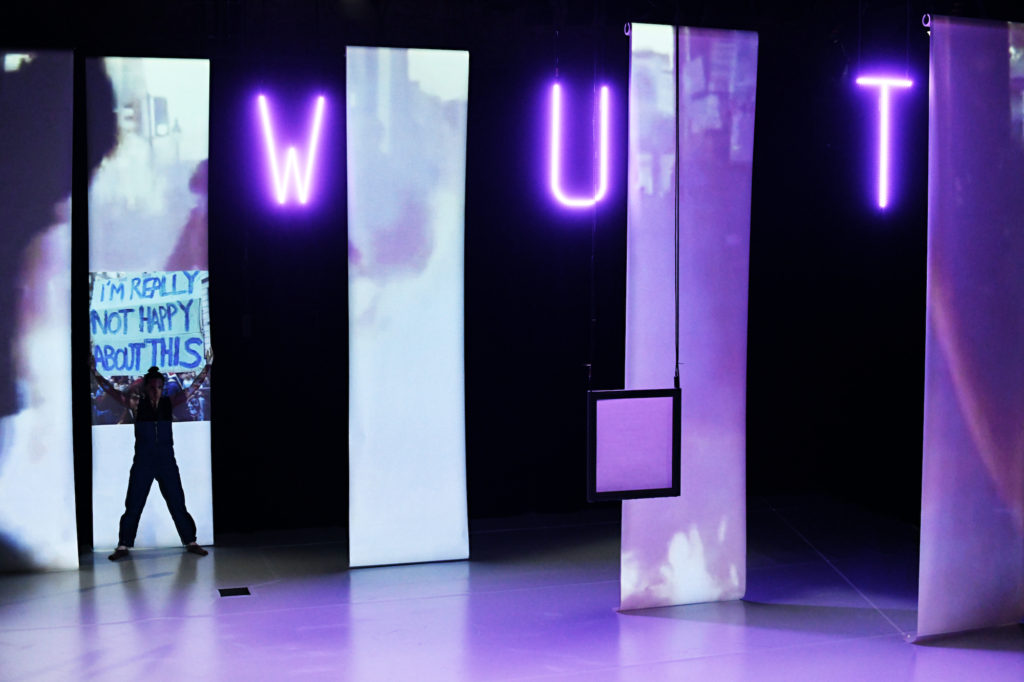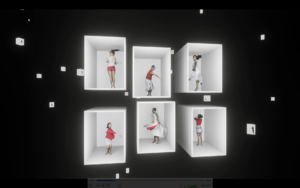Munich and Augsburg: Digital adventures - Vancouver Ballet Society
- Home
- City Reports 2020 - 2023
- Munich and Augsburg: Digital adventures

By Jeannette Andersen
Live performance has been almost non-existent in Munich during the pandemic. Theatres have been closed since March 2020 except for September and October. But with falling infection numbers, curtains rose again at the end of May to limited audiences equipped with negative COVID-19 tests and face-masks.
This does not mean, however, that the dance community was dormant. DANCE 2021’s artistic director, Nina Hümpel, and her team carried through with Munich’s biennial contemporary festival. Not as they had hoped onstage and in public spaces, but as a purely digital event from May 6-16. Names were crossed out in the program because choreographers and dancers could not get to Munich to perform for the livestreams, although the premiere of Jan Martens’ any attempt will end in crushed bodies and shattered bones was streamed from Martens’ home base in Brussels. In the case of Anne Teresa de Keersmaeker and Emanuel Gat, who did not want their pieces, made for the stage, to be streamed, documentaries about the artists were shown instead.
The livestream performances were followed by artist talks, when frustrations during COVID-19 were voiced. But, more importantly, the festival showed how much creativity, innovation and flexibility dancers and dancemakers possess.

Three Munich-based choreographers, each in their own way, used digital media very successfully. Ceren Oran had collected dance improvisations posted on social media from different places in Europe. Out of this material, she created a piece for 15 dancers, The Urge. She had two other choreographers rehearse the piece with dancers in Cologne and Berlin. The Urge was performed simultaneously outdoors in public spaces in all three cities, with live music, and were livestreamed in three frames on screen. For Oran, it was a way to turn the individual COVID-19 experience into a collective one.
For her new piece, Über die Wut (About Anger), Anna Konjetzky chose a traditional stage — at the Münchner Kammerspiele — filmed with an unmoving camera situated in the middle of the auditorium. The solo, danced by the fabulous freelance dancer Sahra Huby, was spellbinding. Huby’s register of anger spanned cartoon-like movements, repressed anger that distorted the body, anger that welled up from her toes and tried to escape through her mouth, aggressive typically masculine gestures and much more. Scenes of violent demonstrations, such as those for Black Lives Matter, and of refugees trying to climb the wall between Mexico and the United States, were projected upstage on white banners because, as Konjetzky explained in her artist talk, we are living in a world of anger.

A moving camera followed dancer/choreographer Judith Hummel and the accordion player Evi Keglmaier in Hummels’ performance piece Wo komme ich her? (From Where Do I Come?), based on her grandmother’s difficult walk from Rumania to Germany during the last years of World War II. In a large factory building turned into a performance space, Hummel walks. Sometimes the camera shows her in full, sometimes just a fragment: her feet in a bowl of water, an elbow, her distorted face. This fragmentation approximates memory, making us realize that neither Hummel nor we shall ever fully fathom her grandmother’s experience.
Among DANCE 2021’s other offerings was a premiere by Richard Siegal, the American choreographer whose company, Ballet of Difference, was formerly based in Munich, and is now in Cologne. Siegal relegated dance to the commercial world with his Two for the Show — All for One and One for the Money. Three simultaneous livestreams — online viewers were able to choose which to enlarge — showed dancers performing, a man playing a computer game while explaining what he was doing, and a man chatting, maybe to friends, maybe to the audience. The monologues were dull, the content trivial. Every so often, a window popped up asking viewers to buy extra material, which could be paid for with a credit card. It was like watching a shopping channel, with the dance reduced to just another commodity, and it was hard to pay it any attention.
Elsewhere, Staatstheater Augsburg, a 30-minute train ride from the centre of Munich, took the biggest leap into the future. Before the first lockdown in 2020, they had staged Gluck’s opera Orpheus as a theatre performance in which the audience would be asked to put on VR goggles every time Orpheus descended into the underworld. However, the premiere was cancelled once theatres closed. Given they already had the equipment, the theatre decided to create an online VR repertoire, which now consists of seven shows, some of which are in English, and two are dance pieces. In Germany, ticket-buyers are sent the VR goggles, which can be kept for two days; outside Germany, the shows are available to a limited selection of European countries, but viewers need to have their own goggles.

A collaborative creation called shifting_perspective featured short solos created by the theatre’s full company of 17 dancers, to music by Robin Rimbaud, alias Scanner. With the VR goggles on, viewers find themselves sitting in the middle of the stage facing the auditorium. I found it a weird experience. Constantly pivoting in my chair, I tried to take in the action that took place all around me. A dancer appeared upstage. A man entered from the side in a menacing manner; I turned away just in time to confront another man a hair’s breadth away. One dancer ended her solo by embracing me; another bolted out from under me; looking down, I saw the stage floor, not my own feet. Although I didn’t feel the impact of their touch, the images of the dancers seemed real.
The theatre’s ballet director, Ricardo Fernando, choreographed the second VR piece, boléro, to Ravel’s music of the same name, in collaboration with the University of Applied Sciences in Augsburg. Here, viewers find themselves sitting in the theatre’s sixth row, facing the dancers who are performing onstage inside six rectangular cubes. The cubes start to move with the dancers inside, becoming part of the choreography; sometimes the group of cubes seem to fly apart from each other, sometimes they tilt precariously, so that you fear the dancers will fall out. It was fun to experience how dancers and cubes came alive together, and as much fun to watch the making-of afterward.
Staatstheater Augsburg’s next VR ballet, also by Fernando and with a premiere in September, is a Romeo-and-Juliet story between a woman and a 2.60 meters (over eight feet) tall industrial robot. I saw a film snippet. It is amazing how much emotion can be created between a woman and an inanimate object.

